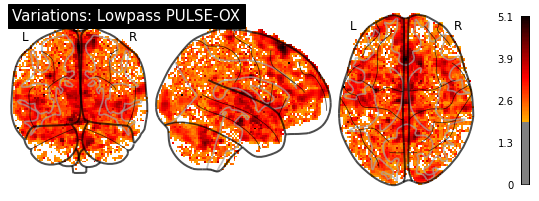Tutorial 4: Regressors from pulse oximeter data
This example shows how to use niphlem for one subject from one of our particular projects. These data consist of one acquisition of resting-state that has been previously preprocesses using fMRIPrep and physiological acquired through a Siemens multiband protocol. Here we concentrate on pulse oximeter data, which contains both breathing (lower frequencies) and cardiac signal (higher frequencies). Look at Verstynen, 2011 for more details on this.
In addition, we are going to show the maps generated by the niphlem generated regressors using the library nilearn (https://nilearn.github.io/).
[2]:
# IMPORTS
import numpy as np
import pandas as pd
from nilearn import image, plotting
from nilearn.glm.first_level import FirstLevelModel
from niphlem.input_data import (load_cmrr_info, load_cmrr_data)
Let’s start definining our data:
[3]:
# Our preprocessed BOLD image
run_img = image.load_img("./data/demo/sub-06_ses-04_task-resting_run-01_space-MNI152NLin2009cAsym_desc-preproc_bold.nii.gz")
# The repetition time of the scanner
t_r = 1.5
# The frame times, used to define the regressors at the precise times
n_vols = run_img.shape[-1]
frame_times = np.arange(n_vols)*t_r
# Our file with the confounder regressors as a Dataframe. It will be used later to extract the motion parameters
conf_df = pd.read_csv("./data/demo/sub-06_ses-04_task-resting_run-01_desc-confounds_regressors.tsv", sep="\t")
# Our physiological data, the info log file and the Pulse-ox log file
info_log = "./data/demo/physio/Physio_20210322_140315_89a222d1-4c24-4caf-a898-f06c6bfd2342_Info.log"
pulse_log = "./data/demo/physio/Physio_20210322_140315_89a222d1-4c24-4caf-a898-f06c6bfd2342_PULS.log"
Load data
The first thing that we need is to load the info file, which will give us the times of the scanner. We can load this kind of the data using the function niphlem.input_data.load_cmrr_info. The only thing that we have to do is to pass the info log file to this function, and it will return the time traces and a dictionary with some meta information which is at the beginning of the file.
[4]:
time_traces, meta_info = load_cmrr_info(info_log)
[5]:
meta_info
[5]:
{'uuid': '89a222d1-4c24-4caf-a898-f06c6bfd2342',
'scan_date': '20210322_140315',
'log_version': 'EJA_1',
'n_slices': 68,
'n_vols': 353,
'n_echoes': 1,
'init_physio': 20241969,
'end_physio': 20457989,
'init_scan': 20246200,
'end_scan': 20457978,
'repetition_time': 600.0}
Now that we have the time traces, we are going to load our pulse-ox data by passing to the function niphlem.input_data.load_cmrr_data its log file and the meta information dictionary that we’ve just generated. This dictionary is required to be able to synchronize the physiological signal with the scanner times. We also specify the type of signal, as a new entry to an updated dictionary will be added, containing meta information of this pulse-ox signal.
[6]:
pulse_signal, meta_info = load_cmrr_data(pulse_log, info_dict=meta_info, sig_type="pulse")
Let’s have a look at the updated information dictionary:
[7]:
meta_info
[7]:
{'uuid': '89a222d1-4c24-4caf-a898-f06c6bfd2342',
'scan_date': '20210322_140315',
'log_version': 'EJA_1',
'n_slices': 68,
'n_vols': 353,
'n_echoes': 1,
'init_physio': 20241969,
'end_physio': 20457989,
'init_scan': 20246200,
'end_scan': 20457978,
'repetition_time': 600.0,
'pulse': {'n_channels': 1, 'sample_rate': 2}}
Let’s have a look into a portion of this signal, corresponding to 4 s:
[8]:
fig, ax = plt.subplots(figsize=(7,5))
plt.plot(pulse_signal[:,0])
plt.xlim([0,1600])
pass
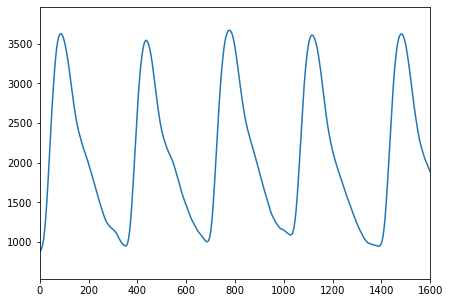
If we inspect the the power spectrum, we could see that there are roughly two peaks, one between [0.1-0.5], corresponding to breathing effects, and another one between [0.5-2], corresponding to cardiac effects (Verstynen, 2011).
[9]:
from scipy.signal import periodogram
f, Pxx = periodogram(pulse_signal.flatten(), fs=400)
max_pxx = max(10*np.log10(Pxx))
fig, ax = plt.subplots(figsize=(10, 7))
plt.plot(f, 10*np.log10(Pxx)/max_pxx)
plt.xlim([0, 2])
plt.ylim([0, 1])
plt.tick_params(labelsize=20)
plt.xlabel("Frequency (Hz)", size=25)
plt.ylabel("STD (db/hz)", size=25)
pass
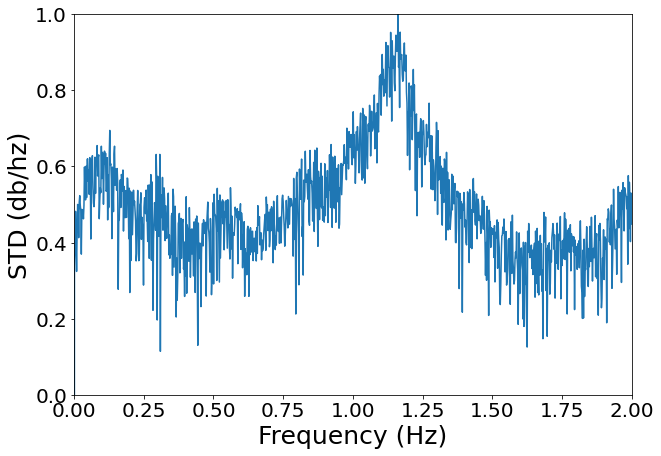
Thus, in the following we are going to consider two signal, a lowpassed filtered signal accounting for breathing effects, and a highpassed filtered signal for cardiac effects. Let’s have a look at how these look like, for which we are going to get help of the function *_transform_filter* in the clean module We are also going to show the peaks detected, for which we will employ the function compute_max_events from events module.
[10]:
from niphlem.clean import _transform_filter
from niphlem.events import compute_max_events
puls_filt_low = _transform_filter(pulse_signal[:,0],
high_pass=0.1,
low_pass=0.5,
sampling_rate=400)
puls_filt_high = _transform_filter(pulse_signal[:,0],
low_pass=2,
high_pass=0.5,
sampling_rate=400)
times = np.arange(pulse_signal.shape[0])*1/400
fig, axs = plt.subplots(ncols=2, figsize=(15, 7))
axs[0].plot(times, puls_filt_low)
# delta 800 corresponds to 0.5 Hz as the fastest frequency, i.e. 60 breats per minute
pks = compute_max_events(puls_filt_low, delta=800, peak_rise=0.5)
axs[0].scatter(times[pks], puls_filt_low[pks], c="r")
axs[0].set_xlim([10000/400, 50000/400])
axs[0].set_ylim([-200, 200])
axs[0].set_xlabel("Time (s)", size=25)
axs[0].set_yticklabels("")
axs[0].tick_params(labelsize=20)
axs[0].set_title("Lowpass PULSE-OX", size=30)
axs[1].plot(times, puls_filt_high)
# delta 200 corresponds to 2 Hz as the fastest frequency
pks = compute_max_events(puls_filt_high, delta=200, peak_rise=0.5)
axs[1].scatter(times[pks], puls_filt_high[pks], c="r")
axs[1].set_xlim([10000/400, 13000/400])
axs[1].set_xlabel("Time (s)", size=25)
axs[1].set_yticklabels("")
axs[1].tick_params(labelsize=20)
axs[1].set_title("Highpass PULSE-OX", size=30)
pass

Retroicor regressors
Let’s start the generation of regressors for the Retroicor Model. The class for generating these regressors is found as niphlem.models.RetroicorPhysio.
[11]:
from niphlem.models import RetroicorPhysio
[12]:
print(RetroicorPhysio.__doc__)
Physiological regressors using Retroicor.
Parameters
----------
physio_rate : float
Sampling rate for the recording in Hz.
This is needed for filtering to define the nyquist frequency.
t_r : float
Repetition time for the scanner (the usual T_R) in secs.
delta: float
minimum separation (in physio recording units) between
events in signal to be considered peaks
peak_rise: float
relative height with respect to the 20th tallest events in signal
to consider events as peak.
order: int or array-like of shape (n_orders,)
Fourier expansion for phases. If int, the fourier expansion is
performed to that order, starting from 1. If an array is provided,
each element will multiply the phases.
transform : {"demean", "zscore", "abs"}, optional
Transform data before filtering. The default is "demean".
high_pass : float, optional
High-pass filtering frequency (in Hz). The default is None.
low_pass : float, optional
Low-pass filtering frequency (in Hz). The default is None.
columns : List or array of n_channels elements, "mean" or None, optional
It describes how to handle input signal channels. If a list, it will
weight each channel and take the dot product. If "mean",
the average across the channels. If None, it will consider each
channel separately. The default is None.
peak_correct : bool, optional
Whether to apply an automatic Grubbs' test for peak outlier
correction. The default is True.
n_jobs : int, optional
Number of jobs to consider in parallel. The default is 1.
Let’s define the objects for both kinds of data. They will be differenciated mainly in the frequency ranges to be passed.
[13]:
retro_breath = RetroicorPhysio(physio_rate=400, # Physiological rate (400 Hz)
t_r=1.5, # Scan rate (1.5 s)
delta=800,
peak_rise=0.5,
high_pass=0.1,
low_pass=0.5, # keep frequencies below this
order=2 # order 2 of the retroicor expansion
)
retro_cardiac = RetroicorPhysio(physio_rate=400, # Physiological rate (400 Hz)
t_r=1.5, # Scan rate (1.5 s)
delta=200,
peak_rise=0.5,
low_pass=2.0, # keep frequencies below this
high_pass=0.5, # keep frequencies above this
order=2 # order 2 of the retroicor expansion
)
Once we have defined this object, we generate the regressors using the method compute_regressors, which is comon to all the models.
[14]:
breath_regressors = retro_breath.compute_regressors(signal=pulse_signal, time_scan=frame_times)
cardiac_regressors = retro_cardiac.compute_regressors(signal=pulse_signal, time_scan=frame_times)
Let’s see the a part of these regressors:
[15]:
fig, axs = plt.subplots(figsize=(15,7), ncols=2, sharex=True)
axs[0].plot(frame_times, breath_regressors[:,0], label="sin1")
axs[0].plot(frame_times, 3 + breath_regressors[:,1], label="cos1")
axs[0].plot(frame_times, 6 + breath_regressors[:,2], label="sin2")
axs[0].plot(frame_times, 9 + breath_regressors[:,3], label="cos2")
axs[0].legend(ncol=2, prop={'size':12})
axs[0].set_xlabel("time (s)", size=25)
axs[0].set_xlim([0,100])
axs[0].tick_params(labelsize=20)
axs[0].set_title("Lowpass PULSE-OX", size=30)
axs[1].plot(frame_times, cardiac_regressors[:,0], label="sin1")
axs[1].plot(frame_times, 3 + cardiac_regressors[:,1], label="cos1")
axs[1].plot(frame_times, 6 + cardiac_regressors[:,2], label="sin2")
axs[1].plot(frame_times, 9 + cardiac_regressors[:,3], label="cos2")
axs[1].legend(ncol=2, prop={'size':12})
axs[1].set_xlabel("time (s)", size=25)
axs[1].set_xlim([0,100])
axs[1].tick_params(labelsize=20)
axs[1].set_title("Highpass PULSE-OX", size=30)
pass
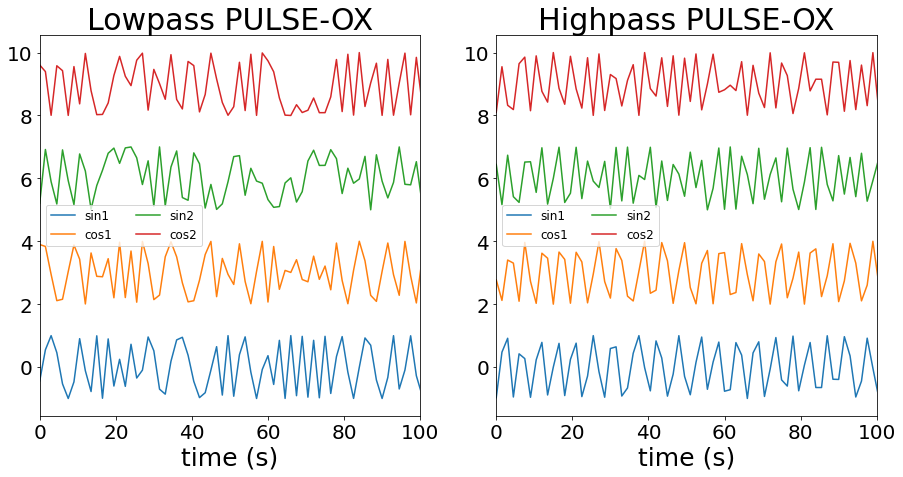
Let’s build now a design matrix that contains these regressors in addition to the motion parameters and an intercept.
[16]:
dm_retroicor = np.column_stack((np.ones(len(frame_times)), # Intercept
conf_df.filter(regex="rot|trans").to_numpy(), # Motion parameters
breath_regressors, # breath retro regressors
cardiac_regressors, # cardiac retro regressors
))
dm_retroicor = pd.DataFrame(dm_retroicor,
columns=["intercept",
"trans_x","trans_y","trans_z","rot_x","rot_y","rot_z",
"breath_sin1", "breath_cos1", "breath_sin2", "breath_cos2",
"cardiac_sin1", "cardiac_cos1", "cardiac_sin2", "cardiac_cos2",
]
)
dm_retroicor.index=frame_times
dm_retroicor.head()
[16]:
| intercept | trans_x | trans_y | trans_z | rot_x | rot_y | rot_z | breath_sin1 | breath_cos1 | breath_sin2 | breath_cos2 | cardiac_sin1 | cardiac_cos1 | cardiac_sin2 | cardiac_cos2 | |
|---|---|---|---|---|---|---|---|---|---|---|---|---|---|---|---|
| 0.0 | 1.0 | 0.031165 | -0.003878 | -0.027213 | -0.001164 | 0.000187 | 0.000000 | -0.444137 | 0.895959 | -0.795857 | 0.605484 | -0.973793 | -0.227434 | 0.442948 | -0.896547 |
| 1.5 | 1.0 | 0.021195 | -0.071983 | -0.047930 | 0.000039 | 0.000260 | 0.000000 | 0.549509 | 0.835488 | 0.918216 | 0.396080 | 0.474220 | -0.880406 | -0.835013 | 0.550230 |
| 3.0 | 1.0 | 0.017855 | -0.041552 | -0.036992 | 0.000027 | 0.000076 | -0.000260 | 0.998598 | -0.052943 | -0.105737 | -0.994394 | 0.915408 | 0.402527 | 0.736953 | -0.675944 |
| 4.5 | 1.0 | 0.013670 | 0.072409 | -0.036982 | -0.000340 | 0.000188 | -0.000202 | 0.458086 | -0.888908 | -0.814393 | 0.580314 | -0.952076 | 0.305862 | -0.582408 | -0.812897 |
| 6.0 | 1.0 | 0.009882 | -0.046013 | -0.040077 | 0.000352 | 0.000367 | -0.000228 | -0.536384 | -0.843974 | 0.905388 | 0.424585 | 0.420688 | -0.907205 | -0.763301 | 0.646043 |
[17]:
fig, ax = plt.subplots(figsize=(10,5))
ax.pcolormesh(dm_retroicor)
ax.set_xticks(0.5 + np.arange(dm_retroicor.shape[1]))
ax.set_xticklabels(dm_retroicor.columns, rotation=45, size=15)
pass
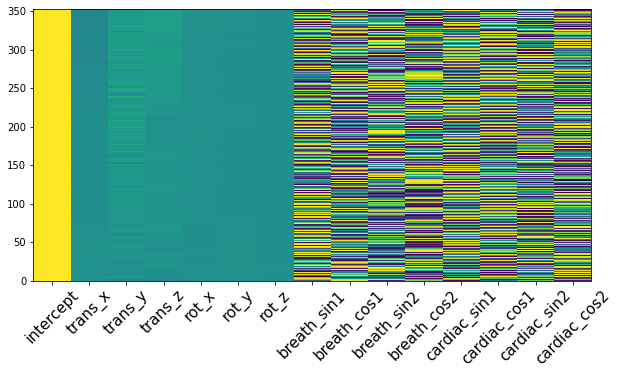
Now fit this design matrix to our BOLD image:
[18]:
first_level = FirstLevelModel(t_r=t_r, drift_model=None, signal_scaling=False, smoothing_fwhm=6)
first_level.fit(run_imgs=run_img, design_matrices=dm_retroicor)
breath_retro_map = first_level.compute_contrast("breath_sin1+breath_cos1+breath_sin2+breath_cos2",
stat_type="F", output_type="z_score")
cardiac_retro_map = first_level.compute_contrast("cardiac_sin1+cardiac_cos1+cardiac_sin2+cardiac_cos2",
stat_type="F", output_type="z_score")
And show the z-stat maps for both:
[19]:
plotting.plot_glass_brain(breath_retro_map, threshold=1.96, colorbar=True,
title="RETROICOR: Lowpass PULSE-OX")
plotting.plot_glass_brain(cardiac_retro_map, threshold=1.96, colorbar=True,
title="RETROICOR: Highpass PULSE-OX")
[19]:
<nilearn.plotting.displays.OrthoProjector at 0x7fc1282472b0>

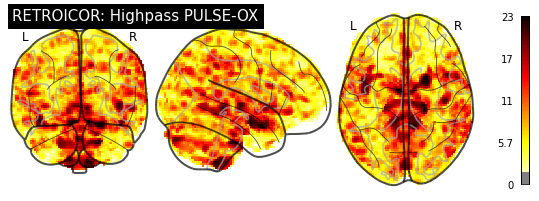
Variation model’s regressors
Let’s continue now with the generation of regressors using the Variation Model. The classes for generating these regressors are found as niphlem.models.HVPhysio for cardiac effects, and niphlem.models.RVPhysio for breathing effects.
[20]:
from niphlem.models import HVPhysio, RVPhysio
Let’s look at the documentation of both:
[21]:
print(RVPhysio.__doc__)
Physiological regressors for variations in breathing rate/volume.
Parameters
----------
physio_rate : float
Sampling rate for the recording in Hz.
This is needed for filtering to define the nyquist frequency.
t_r : float
Repetition time for the scanner (the usual T_R) in secs.
time_window : float
Time window (in secs) around the T_R from which computing variations
(standard deviation of signal). The default is 6 secs.
transform : {"demean", "zscore", "abs"}, optional
Transform data before filtering. The default is "demean".
high_pass : float, optional
High-pass filtering frequency (in Hz). The default is None.
low_pass : float, optional
Low-pass filtering frequency (in Hz). The default is None.
columns : List or array of n_channels elements, "mean" or None, optional
It describes how to handle input signal channels. If a list, it will
weight each channel and take the dot product. If "mean",
the average across the channels. If None, it will consider each
channel separately. The default is None.
n_jobs : int, optional
Number of jobs to consider in parallel. The default is 1.
[22]:
print(HVPhysio.__doc__)
Physiological regressors for variations in heart rate.
Parameters
----------
physio_rate : float
Sampling rate for the recording in Hz.
This is needed for filtering to define the nyquist frequency.
t_r : float
Repetition time for the scanner (the usual T_R) in secs.
delta: float
minimum separation (in physio recording units) between
events in signal to be considered peaks
peak_rise: float
relative height with respect to the 20th tallest events in signal
to consider events as peak.
time_window : float
Time window (in secs) around the T_R from which computing variations
(time differences between signal events ). The default is 6 secs.
transform : {"demean", "zscore", "abs"}, optional
Transform data before filtering. The default is "demean".
high_pass : float, optional
High-pass filtering frequency (in Hz). The default is None.
low_pass : float, optional
Low-pass filtering frequency (in Hz). The default is None.
columns : List or array of n_channels elements, "mean" or None, optional
It describes how to handle input signal channels. If a list, it will
weight each channel and take the dot product. If "mean",
the average across the channels. If None, it will consider each
channel separately. The default is None.
peak_correct : bool, optional
Whether to apply an automatic Grubbs' test for peak outlier
correction. The default is True.
n_jobs : int, optional
Number of jobs to consider in parallel. The default is 1.
[23]:
variaton_breath = RVPhysio(physio_rate=400,
t_r=t_r,
time_window=4.5, # 3 T_R
low_pass=0.5,
high_pass=0.1)
variaton_cardiac = HVPhysio(physio_rate=400,
t_r=t_r,
delta=200,
peak_rise=0.5,
time_window=4.5, # 3 T_R
low_pass=2.0,
high_pass=0.5)
As before, we can generate the regressors using the method compute_regressors.
[24]:
breath_regressors = variaton_breath.compute_regressors(signal=pulse_signal, time_scan=frame_times)
cardiac_regressors = variaton_cardiac.compute_regressors(signal=pulse_signal, time_scan=frame_times)
Let’s plot a snapshot of both:
[25]:
fig, axs = plt.subplots(figsize=(7,5))
axs.plot(frame_times, breath_regressors[:,0], label="breath")
axs.plot(frame_times, cardiac_regressors[:,0], label="cardiac")
plt.xlim([0, 200])
plt.ylim([-12,12])
plt.xlabel("time (s)", size=25)
plt.legend(prop={'size':12})
plt.tick_params(labelsize=20)
pass

[26]:
dm_variation = np.column_stack((np.ones(len(frame_times)), # Intercept
conf_df.filter(regex="rot|trans").to_numpy(), # Motion parameters
breath_regressors, # breath variation regressors
cardiac_regressors, # cardiac variation regressors
))
dm_variation = pd.DataFrame(dm_variation,
columns=["intercept",
"trans_x","trans_y","trans_z","rot_x","rot_y","rot_z",
"breath_var",
"cardiac_var"
]
)
dm_variation.index=frame_times
dm_variation.head()
[26]:
| intercept | trans_x | trans_y | trans_z | rot_x | rot_y | rot_z | breath_var | cardiac_var | |
|---|---|---|---|---|---|---|---|---|---|
| 0.0 | 1.0 | 0.031165 | -0.003878 | -0.027213 | -0.001164 | 0.000187 | 0.000000 | 0.000000 | -0.000102 |
| 1.5 | 1.0 | 0.021195 | -0.071983 | -0.047930 | 0.000039 | 0.000260 | 0.000000 | 1.550640 | 0.099650 |
| 3.0 | 1.0 | 0.017855 | -0.041552 | -0.036992 | 0.000027 | 0.000076 | -0.000260 | 5.713570 | 0.189940 |
| 4.5 | 1.0 | 0.013670 | 0.072409 | -0.036982 | -0.000340 | 0.000188 | -0.000202 | 10.554199 | -0.337274 |
| 6.0 | 1.0 | 0.009882 | -0.046013 | -0.040077 | 0.000352 | 0.000367 | -0.000228 | 11.312013 | -2.589158 |
[27]:
fig, ax = plt.subplots()
ax.pcolormesh(dm_variation)
ax.set_xticks(0.5 + np.arange(dm_variation.shape[1]))
ax.set_xticklabels(dm_variation.columns, rotation=45, size=15)
pass
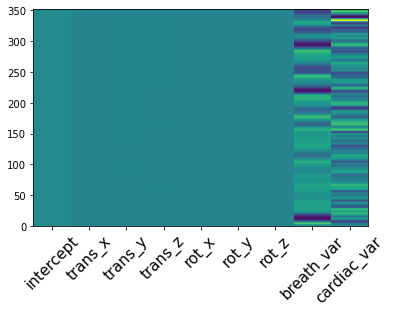
As before, let’s fit this design matrix to our BOLD data:
[28]:
first_level = FirstLevelModel(t_r=t_r, drift_model=None, signal_scaling=False, smoothing_fwhm=6)
first_level.fit(run_imgs=run_img, design_matrices=dm_variation)
breath_variation_map = first_level.compute_contrast("breath_var",
stat_type="F", output_type="z_score")
cardiac_variation_map = first_level.compute_contrast("cardiac_var",
stat_type="F", output_type="z_score")
And plot these maps:
[29]:
plotting.plot_glass_brain(breath_variation_map, threshold=1.96, colorbar=True,
title="Variations: Lowpass PULSE-OX")
plotting.plot_glass_brain(cardiac_variation_map, threshold=1.96, colorbar=True,
title="Variations: Highpass PULSE-OX")
[29]:
<nilearn.plotting.displays.OrthoProjector at 0x7fc12ba2b520>
